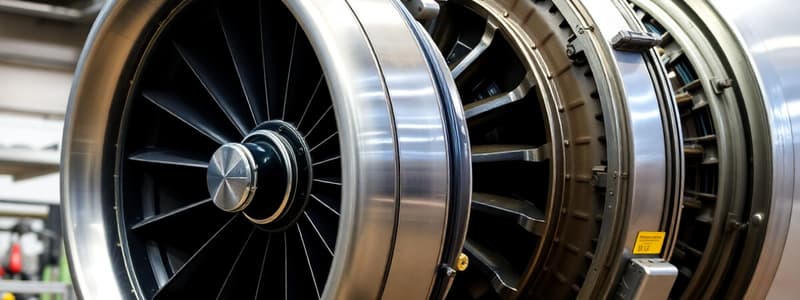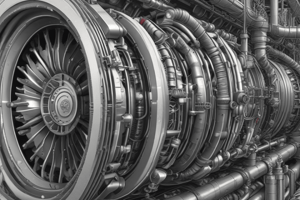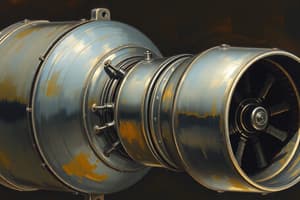Podcast
Questions and Answers
What distinguishes aviation lubricants from other types of lubricants concerning operational altitude effects?
What distinguishes aviation lubricants from other types of lubricants concerning operational altitude effects?
- Increased flammability to ensure combustion in low-oxygen environments
- Low volatility to minimize evaporation at high altitudes (correct)
- Lower anti-forming characteristics due to reduced air density
- Higher viscosity to compensate for thinner air
What design consideration primarily allows operators to manually verify adequate oil levels in a turbine engine's lubrication system?
What design consideration primarily allows operators to manually verify adequate oil levels in a turbine engine's lubrication system?
- A sight glass or dipstick incorporated into the oil tank design (correct)
- An electronic sensor linked to the Engine Electronic Controller (ECC)
- A centrally located pressure relief valve with external access
- An integrated magnetic chip detector for real-time quality analysis
In a full-flow type lubrication system, what is the primary mechanism for managing excess oil when the engine is operating at maximum RPM?
In a full-flow type lubrication system, what is the primary mechanism for managing excess oil when the engine is operating at maximum RPM?
- The oil is temporarily stored in an accumulator until needed
- The excess oil is expelled through a breather vent to reduce pressure
- A pressure relief valve redirects excess oil back to the supply pump's inlet (correct)
- The oil is diverted to a secondary cooling loop before returning to the tank
What necessitates that oil pump drive-shaft designs avoid incorporating a weak shear neck?
What necessitates that oil pump drive-shaft designs avoid incorporating a weak shear neck?
What role does the deoiler play within the breather line of a turbine engine's lubrication system?
What role does the deoiler play within the breather line of a turbine engine's lubrication system?
High oil temperature often triggers engine shutdown. What primary risk is mitigated by preventing continued operation under these conditions?
High oil temperature often triggers engine shutdown. What primary risk is mitigated by preventing continued operation under these conditions?
What is the operational significance of excellent film strength in aviation lubricants?
What is the operational significance of excellent film strength in aviation lubricants?
What is the purpose of the last chance strainers/filters in a full flow lubricating system of a turbine engine?
What is the purpose of the last chance strainers/filters in a full flow lubricating system of a turbine engine?
What inherent limitation in wet sump lubrication systems makes them unsuitable for modern turbine engines, especially in axial-flow configurations?
What inherent limitation in wet sump lubrication systems makes them unsuitable for modern turbine engines, especially in axial-flow configurations?
What critical function is served by the magnetic chip detector installed in a turbine engine's lubrication system?
What critical function is served by the magnetic chip detector installed in a turbine engine's lubrication system?
What operational parameter of the oil system in a turbine engine primarily dictates the sizing and capacity of the pressure pump?
What operational parameter of the oil system in a turbine engine primarily dictates the sizing and capacity of the pressure pump?
In the context of aviation lubricants, what does a high viscosity index signify regarding the lubricant's performance under varying temperature conditions?
In the context of aviation lubricants, what does a high viscosity index signify regarding the lubricant's performance under varying temperature conditions?
Unlike traditional solvent-based cleaning methods, describe the function of an ultra sound machine during oil filter maintenance.
Unlike traditional solvent-based cleaning methods, describe the function of an ultra sound machine during oil filter maintenance.
What is the standard post-shutdown timeframe within which the oil tank of a turbine engine should be inspected and refilled up to its designated level?
What is the standard post-shutdown timeframe within which the oil tank of a turbine engine should be inspected and refilled up to its designated level?
What key operational difference distinguishes an air-cooled oil cooler from a fuel-cooled oil cooler in a gas turbine engine?
What key operational difference distinguishes an air-cooled oil cooler from a fuel-cooled oil cooler in a gas turbine engine?
Which of these purposes are accomplished by a turbine engine lubrication system?
Which of these purposes are accomplished by a turbine engine lubrication system?
What is the functional relationship between the Pressure Relief Valve and the oil flow to the bearing chambers in a turbine engine Lubrication System?
What is the functional relationship between the Pressure Relief Valve and the oil flow to the bearing chambers in a turbine engine Lubrication System?
What criteria determines when particles found on a filter surface during maintenance inspection indicate a severe operational problem?
What criteria determines when particles found on a filter surface during maintenance inspection indicate a severe operational problem?
What attribute must an oil tank possess to properly maintain a turbine engine lubrication system?
What attribute must an oil tank possess to properly maintain a turbine engine lubrication system?
In the operational sequence of a full flow lubricating system, what component directly precedes the bearing compartments and gearboxes, ensuring optimal lubricant purity?
In the operational sequence of a full flow lubricating system, what component directly precedes the bearing compartments and gearboxes, ensuring optimal lubricant purity?
In a turbine engine lubrication system, where are magnetic plugs or chip detectors typically situated to effectively collect wear debris?
In a turbine engine lubrication system, where are magnetic plugs or chip detectors typically situated to effectively collect wear debris?
What is the main function of synthetic oil when utilized in modern gas turbine engines?
What is the main function of synthetic oil when utilized in modern gas turbine engines?
How does a fuel-cooled oil cooler effectively reduce oil temperature in a turbine engine?
How does a fuel-cooled oil cooler effectively reduce oil temperature in a turbine engine?
Which statement accurately describes the configuration of a gear-type pump?
Which statement accurately describes the configuration of a gear-type pump?
What fundamental characteristic differentiates a dry sump lubrication system?
What fundamental characteristic differentiates a dry sump lubrication system?
What specific function do coarse strainers perform within a turbine engine's lubrication system, particularly concerning pump protection?
What specific function do coarse strainers perform within a turbine engine's lubrication system, particularly concerning pump protection?
In relation to the lubrication of turbine engines, what does the term 'anti-forming characteristics' refer to?
In relation to the lubrication of turbine engines, what does the term 'anti-forming characteristics' refer to?
What distinguishes the operational characteristics of a vane-type pump from those of a gear-type pump in an oil lubrication system?
What distinguishes the operational characteristics of a vane-type pump from those of a gear-type pump in an oil lubrication system?
When examining the condition of a removed magnetic chip detector during routine maintenance, what specific finding would most strongly suggest an impending component failure?
When examining the condition of a removed magnetic chip detector during routine maintenance, what specific finding would most strongly suggest an impending component failure?
What purpose does oil damping serve within a turbine engine lubrication system?
What purpose does oil damping serve within a turbine engine lubrication system?
In a full flow lubricating system, what action is initiated when oil pressure before the filter surpasses a set threshold?
In a full flow lubricating system, what action is initiated when oil pressure before the filter surpasses a set threshold?
What is the primary reason modern gas turbine engines commonly depend on synthetic oil?
What is the primary reason modern gas turbine engines commonly depend on synthetic oil?
An air/oil heat exchanger utilizes what property to lower the temperature?
An air/oil heat exchanger utilizes what property to lower the temperature?
A pop-up indicator serves what purpose in a filter?
A pop-up indicator serves what purpose in a filter?
What is the correct order of components on the scavenge line in a full-flow lubrication system?
What is the correct order of components on the scavenge line in a full-flow lubrication system?
Considering the operational demands of modern turbine engines, why are dry sump lubrication systems more appropriate than wet sump systems?
Considering the operational demands of modern turbine engines, why are dry sump lubrication systems more appropriate than wet sump systems?
Given the essential role of the oil pump assembly, what design characteristic is most critical for the scavenge pump component to ensure reliable engine operation?
Given the essential role of the oil pump assembly, what design characteristic is most critical for the scavenge pump component to ensure reliable engine operation?
What is the expected operational outcome if a turbine engine's pressure relief valve fails to open despite oil pressure exceeding the set threshold?
What is the expected operational outcome if a turbine engine's pressure relief valve fails to open despite oil pressure exceeding the set threshold?
How does a fuel-cooled oil cooler's design specifically mitigate the risk of fuel contamination within the oil system, ensuring the integrity of both fluids?
How does a fuel-cooled oil cooler's design specifically mitigate the risk of fuel contamination within the oil system, ensuring the integrity of both fluids?
Considering the location and function of magnetic chip detectors, what differentiates the electric magnetic chip detector from the standard magnetic chip detector in a turbine engine lubrication system?
Considering the location and function of magnetic chip detectors, what differentiates the electric magnetic chip detector from the standard magnetic chip detector in a turbine engine lubrication system?
Flashcards
Lubrication System
Lubrication System
Provides lubrication and cooling for gears, bearings, and splines.
Lubrication Purpose
Lubrication Purpose
Reduces friction and wear between mating parts.
Cleaning Moving Parts
Cleaning Moving Parts
Removes metal particles formed during wear.
Cooling Hot Parts
Cooling Hot Parts
Signup and view all the flashcards
Oil Damping
Oil Damping
Signup and view all the flashcards
Low Volatility
Low Volatility
Signup and view all the flashcards
Anti-Forming Characteristics
Anti-Forming Characteristics
Signup and view all the flashcards
High Flash Point
High Flash Point
Signup and view all the flashcards
Wide Temp Range
Wide Temp Range
Signup and view all the flashcards
Excellent Film Strength
Excellent Film Strength
Signup and view all the flashcards
High Viscosity Index
High Viscosity Index
Signup and view all the flashcards
Wet Sump System
Wet Sump System
Signup and view all the flashcards
Oil in Engine Sump
Oil in Engine Sump
Signup and view all the flashcards
Lubricated Parts
Lubricated Parts
Signup and view all the flashcards
Dry Sump System
Dry Sump System
Signup and view all the flashcards
Pressure Pump
Pressure Pump
Signup and view all the flashcards
Scavenge Pump
Scavenge Pump
Signup and view all the flashcards
Full Flow System
Full Flow System
Signup and view all the flashcards
Pressure Relief Valve
Pressure Relief Valve
Signup and view all the flashcards
Pump Size Determination
Pump Size Determination
Signup and view all the flashcards
Oil System Components
Oil System Components
Signup and view all the flashcards
Oil Tank Placement
Oil Tank Placement
Signup and view all the flashcards
Provision Necessity
Provision Necessity
Signup and view all the flashcards
Sight Glass/Dipstick
Sight Glass/Dipstick
Signup and view all the flashcards
Oil Pumps
Oil Pumps
Signup and view all the flashcards
Pump Failure
Pump Failure
Signup and view all the flashcards
Drive Shafts
Drive Shafts
Signup and view all the flashcards
Gear Pump Composition
Gear Pump Composition
Signup and view all the flashcards
Gears Rotation
Gears Rotation
Signup and view all the flashcards
Pressure Relief Valve
Pressure Relief Valve
Signup and view all the flashcards
Spring Loaded Valve
Spring Loaded Valve
Signup and view all the flashcards
Fuel-Cooled Oil Cooler
Fuel-Cooled Oil Cooler
Signup and view all the flashcards
Air-Cooled Oil Cooler
Air-Cooled Oil Cooler
Signup and view all the flashcards
Centrifugal Breather
Centrifugal Breather
Signup and view all the flashcards
Magnetic Chip Detector
Magnetic Chip Detector
Signup and view all the flashcards
Examination Provision
Examination Provision
Signup and view all the flashcards
Filter Function
Filter Function
Signup and view all the flashcards
Coarse Strainers
Coarse Strainers
Signup and view all the flashcards
Fine Pressure Filter
Fine Pressure Filter
Signup and view all the flashcards
'Pop up indicator'
'Pop up indicator'
Signup and view all the flashcards
Thread-type oil filter
Thread-type oil filter
Signup and view all the flashcards
synthetic oil for lubrication
synthetic oil for lubrication
Signup and view all the flashcards
Oil taks inspected in
Oil taks inspected in
Signup and view all the flashcards
Oil Quantity
Oil Quantity
Signup and view all the flashcards
low oil pressure
low oil pressure
Signup and view all the flashcards
High oil temperature
High oil temperature
Signup and view all the flashcards
Study Notes
Introduction to Lubrication Systems
- Lubrication systems provide lubrication and cooling for gears, bearings, and splines.
- Lubrication systems collect foreign matter from the oil tank, bearing housing, or gearbox.
- Lubrication systems protect lubricated components made of non-corrosion resistant materials.
- Oil must maintain integrity without significant deterioration.
Purpose of Turbine Engine Lubrication
- Lubricating mating parts reduces friction and wear.
- Cleaning moving parts removes metal particles formed during wear and tear, preventing further damage.
- Cooling hot parts prevents heat-induced degradation of material properties and potential seizure of parts.
- Oil damping reduces vibration.
Requirements of Aviation Lubricants
- Low volatility reduces evaporation at high altitudes.
- Anti-forming characteristics ensure positive lubrication.
- High flash point is required.
- Wide temperature range capability.
- Excellent film strength qualities of cohesion and adhesion.
- High viscosity index indicates that the viscosity of the oil is retained when heated.
Types of Oil Systems
- Wet Sump Lubrication System
- This is the oldest design and is rarely seen in modern engines.
- The oil is contained integrally in an engine sump.
- The parts to be lubricated are immersed partially or fully in a bath of oil.
- Dry Sump Lubrication System
- Most modern turbine engines of the axial flow configuration use a Dry Sump Lubrication System.
- A Dry Sump Lubrication Subsystem contains a Pressure, Scavenge, and Breather vent.
- Oil is supplied to the lubricating parts by pressure pumps and is returned to the tank by Scavenge pumps.
- Full Flow Type Oil System (Dry Sump)
- This system achieves desired oil flow rates by dispensing oil based on maximum RPM.
- Excess oil returns through the Pressure Relief Valve to the feeding point of the Supply Pump.
- The pressure pump size is determined by the flow required at maximum engine speed.
Operation of a Full Flow Lubricating System (Supply)
- Oil flows from the tank to the pressure stage in the lubrication and scavenge oil pump.
- The oil pump pressurizes the oil and sends it to the main oil filter.
- If oil pressure before the filter exceeds the set pressure, some oil goes through a pressure relief valve and back to the oil tank.
- From the main oil filter, the oil is sent to the engine air/oil heat exchanger.
- The oil then goes to the fuel oil cooler.
- At the top of the fuel oil cooler, a manifold distributes oil.
- The manifold sends oil through the last chance strainers/filters, and to the bearing compartments and gearboxes.
Operation of a Full Flow Lubricating System (Scavenge Line)
- Oil is removed from the bearing compartments and gearboxes by the scavenge oil pumps.
- A Magnetic Chip Detector helps remove ferrous metal chips or powder from the bearings before the oil reaches the scavenge pump.
- After the scavenge pump, oil travels to the Electric Magnetic Chip Detector and Oil Temperature Sensor before returning to the Oil Tank.
Operation of a Full Flow Lubricating System (Breather Line)
- Oil mist is removed from the breather air by the deoiler (centrifugal breather).
- From the deoiler, oil goes to the Tank, and breather air is vented overboard.
- any left over Oil mist at the LP Turbine will be flushed out from the exhaust.
Components of Oil System
- Oil Tank
- Pressure & Scavenge Pumps
- Pressure Relief Valves
- Fuel Oil Heat Exchanger/Oil Cooler
- Air Oil Heat Exchanger
- Deoiler/Centrifugal Breather
- Magnetic Chip Detectors
- Filters
Oil Tank
- The oil tank is usually mounted and is normally a separate unit but may be part of the external gearbox.
- It has a provision to allow the lubrication system to be drained and replenished.
- A sight glass or dipstick is used to check the oil level.
Oil Pump
- Oil pumps are vital to the efficient operation of the engine.
- Failure of the pumps will necessitate a rapid shutdown.
- The oil pump drive-shafts do not have a weak shear neck.
- They continue to supple oil regardless of damage.
- The Supply pump integrated together with the Scavenge pump is in an Oil Pump Assembly.
Gear Type Pump
- Gear pumps: intermeshing steel gears in a close-fitting aluminum casing.
- When the steel gears are rotating, the oil is between the teeth and casing.
- Gear pumps pressure (feed) pumps and/or scavenge (return) pumps.
- The Accessory drive system drives the oil pumps pack.
Other Types of Pump - Vane type pump
- Refer to FIG 4 for illustration on SLIDING-VANE-TYPE OIL PUMP
Pressure Relief Valve System
- The Pressure Relief Valve system in the oil flow is controlled by pressure in the feed line.
- The spring-loaded valve allows oil to be returned to the oil tank or pressure pump inlet when the design value is exceeded.
Fuel-Cooled Oil Cooler
- A large number of tubes convey the fuel through the matrix.
- The baffle plates direct the oil in series, across the tubes.
- Heat transfers from the oil to the fuel, lowering the oil temperature.
Air-Cooled Oil Cooler
- The air-cooled oil cooler is similar to the fuel-cooled type.
- The main difference is that atmospheric/ram air is used as the cooling medium.
Centrifugal Breather
- Refer to CENTRIFUGAL BREATHER illustration
Magnetic Chip Detector
- Plugs or chip detectors fit on the scavenge (return) side to collect ferrite debris in the bearing chamber.
- They are permanent magnets retained in self-sealing valve housings.
- Testing detectors warns of failing bearings and splines.
- Maintenance inspections are designed to be removed to monitor the purposes without oil loss.
Filters
- Filters and strainers prevent foreign matter from circulating.
- Coarse strainers fit at the oil tank outlet or before the pumps to prevent them from damaging.
- A fine pressure filter after the pressure pump keeps particles from blocking the oil feed jets.
- A "pop up indicator" on the filter housing gives a visual warning of a blocked filter.
Filter Types
- Thread-type Oil Filter (fine):
- These filters are 'last chance' and immediately upstream of the oil jets.
- Electronic Cleaning Of A Cleanable Filter
- Hand cleaning with solvent is accepted.
- Ultrasounds are needed to clean the systems.
- Metals on the filter are normal.
- A high contamination level could mean failure.
- Draining will be rerunning the engine to inspect.
Important Facts on Oil System
- Modern gas turbine engines use synthetic oil for lubrication:
- Mobil jet type II oil, exxon 2380.
- The Oil tank in inspected within 10 minutes after shutdown.
- The oil tank is usually filled to the neck, and a change in oil height means expansion.
- Oil quantity is read via a sight glass or on a gauge from the LED screen engine page.
- Low oil pressure (red warning light) indicates engine shutdown.
- High oil temperature drives an engine shutdown too.
Recap
- What is a lubricating systems?
- What are the 4 principles of engine lubrication?
- What is the Wet sump vs Dry Sump engine difference?
- Draw the Hot Oil Tank Full Flow Lubrication System
- What is the functionality of all major components in the diagram
- Name an important fact of an oil system relating to shutdown
Studying That Suits You
Use AI to generate personalized quizzes and flashcards to suit your learning preferences.




